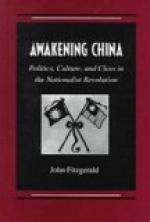It is not without significance that the Chinese have sought presidents for their highest schools among the ranks of Protestant missionaries. Dr. Ferguson of the Methodist Episcopal Mission was called to the presidency of the Nanyang College at Shanghai; Dr. Hayes, to be head of a new university in Shantung; and Dr. Martin, after serving for twenty-five years as head of the Diplomatic College in Peking, was, in 1898, made president of the new Imperial University. His appointment was by decree from the Throne, published in the Government Gazette; and mandarin rank next to the highest was conferred on him. On terminating his connection with that institution, after it was broken up by Boxers, he was recalled to China to take charge of a university for the two provinces of Hupeh and Hunan.
CREATORS OF CHINESE JOURNALISM
In the movement of modern society, no force is more conspicuous than journalism. In this our missionaries have from the first taken a leading part, as it was they who introduced it to China. At every central station for the last half-century periodicals have been issued by them in the Chinese language. [Page 290] The man who has done most in this line is Dr. Y. J. Allen, of the Methodist Episcopal Church South. He has devoted a lifetime to it, besides translating numerous books.
Formerly the Chinese had only one newspaper in the empire—the Peking Gazette, the oldest journal in the world. They now have, in imitation of foreigners, some scores of dailies, in which they give foreign news, and which they print in foreign type. The highest mandarins wince under their stinging criticisms.
THEY LEAD A VERNACULAR REVOLUTION
It is one of the triumphs of Christianity to have given a written form to the language of modern Europe. It is doing the same for heathen nations in all parts of the earth. Nor does China offer an exception. The culture for which her learned classes are noted is wholly confined to a classic language that is read everywhere, and spoken nowhere, somewhat as Latin was in the West in the Middle Ages, save that Latin was really a tongue capable of being employed in speech, whereas the classical language of China is not addressed to the ear but to the eye, being, as Dr. Medhurst said, “an occulage, not a language.”
The mandarin or spoken language of the north was, indeed, reduced to writing by the Chinese themselves; and a similar beginning was made with some of the southern dialects. In all these efforts the Chinese ideographs have been employed; but so numerous and disjointed are they that the labour of years is required to get a command of them even for reading in a vernacular [Page 291] dialect. In all parts of China our missionaries have rendered the Scriptures into the local dialects. so that they may be understood when read aloud, and that every man “may hear in his own tongue the wonderful works of God.” In some places they have printed them in the vernacular by the use of Chinese characters. Yet those characters are clumsy instruments for the expression of sounds; and in several provinces our missionaries have tried to write Chinese with Roman letters.




